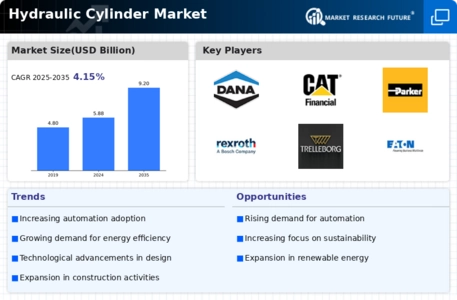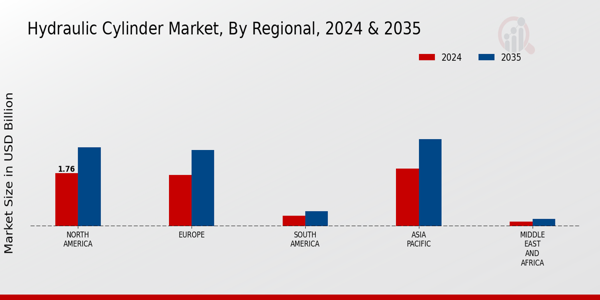Market Growth Projections
The Global Hydraulic Cylinder Market Industry is projected to experience substantial growth over the coming years. With a market value of 5.88 USD Billion in 2024, it is expected to reach 9.2 USD Billion by 2035, reflecting a compound annual growth rate (CAGR) of 4.15% from 2025 to 2035. This growth trajectory suggests a strong demand for hydraulic cylinders across various applications, driven by technological advancements, increased mechanization, and expanding industries. The market's evolution is indicative of broader trends in automation and efficiency, highlighting the hydraulic cylinder's integral role in modern industrial applications.
Growth in Renewable Energy Sector
The Global Hydraulic Cylinder Market Industry is poised to benefit from the growth of the renewable energy sector. Hydraulic systems are increasingly utilized in Steel Wind Tower and hydroelectric power plants, where they play a crucial role in energy generation and management. As countries invest in sustainable energy solutions, the demand for hydraulic cylinders in these applications is expected to rise. This trend aligns with global efforts to transition towards cleaner energy sources, potentially driving the market's expansion. The anticipated growth in renewable energy initiatives may further solidify the hydraulic cylinder's role in supporting sustainable development.
Rising Agricultural Mechanization
The Global Hydraulic Cylinder Market Industry is significantly influenced by the rising trend of agricultural mechanization. As farmers seek to improve productivity and efficiency, the adoption of hydraulic-powered equipment such as tractors and harvesters is on the rise. This shift towards mechanization is particularly evident in developing regions, where agricultural practices are evolving rapidly. The demand for hydraulic cylinders in agricultural machinery is expected to contribute to the market's growth, with projections indicating a market value of 9.2 USD Billion by 2035. This trend underscores the importance of hydraulic technology in modernizing agricultural practices worldwide.
Expansion of Manufacturing Industries
The Global Hydraulic Cylinder Market Industry is significantly impacted by the expansion of manufacturing industries across various sectors. As manufacturing processes become more automated and efficient, the demand for hydraulic cylinders in machinery and equipment is increasing. Industries such as automotive, aerospace, and heavy machinery are particularly reliant on hydraulic systems for their operations. This growing reliance is expected to drive the market's growth, with a projected increase in value to 9.2 USD Billion by 2035. The expansion of manufacturing capabilities globally indicates a robust future for hydraulic cylinder applications in enhancing productivity and operational efficiency.
Increasing Demand from Construction Sector
The Global Hydraulic Cylinder Market Industry experiences a notable surge in demand driven by the construction sector. As urbanization accelerates, the need for heavy machinery such as excavators and loaders increases, which rely heavily on hydraulic cylinders for operation. In 2024, the market is projected to reach 5.88 USD Billion, reflecting the construction industry's expansion. This trend is likely to continue, as infrastructure projects worldwide require advanced hydraulic systems to enhance efficiency and productivity. The construction sector's growth is anticipated to significantly contribute to the overall market dynamics, indicating a robust future for hydraulic cylinder applications.
Technological Advancements in Hydraulic Systems
Technological innovations play a pivotal role in shaping the Global Hydraulic Cylinder Market Industry. The integration of smart technology and automation in hydraulic systems enhances performance and reliability. For instance, the development of IoT-enabled hydraulic cylinders allows for real-time monitoring and predictive maintenance, reducing downtime and operational costs. As industries increasingly adopt these advanced systems, the market is expected to grow steadily. The projected CAGR of 4.15% from 2025 to 2035 suggests that ongoing advancements will continue to drive market expansion, as manufacturers strive to meet the evolving needs of various sectors.























Leave a Comment